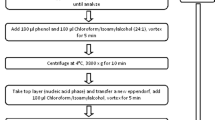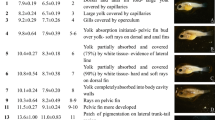Abstract
Eggs from two separate spawning stocks of the red drum Sciaenops ocellatus (Linnaeus) were hatched, and the larvae were reared in the laboratory for 2 wk under closely controlled conditions. Total RNA, DNA, and soluble protein were measured in each population daily in triplicate pooled samples of larvae from each of three tanks. Growth rate in mm d-1 was determined for each population at 2 d intervals. Growth rate explained 72 and 95% of the variation in the RNA:DNA ratios of the two populations individually, and 86% of the variation in the RNA:DNA ratio when data from the two populations were combined. The RNA:DNA ratio appeared to be most effective as an indicator of growth in rapidly growing larvae, and to lose some resolution when growth was intermittent. The rates of deposition of RNA, DNA, and protein into tissue were all highly correlated with growth rate and with each other. Mean population RNA:DNA ratios of red drum yolk-sac larvae decreased from Day 1 post-hatch until larvae initiated successful feeding behavior, and then increased steadily throghout the remainder of the experimental period. This pattern of change in the RNA:DNA ratios during the yolk-sac stage appears to be an intrinsic developmental pattern of red drum ontogeny. The lowest values for the RNA:DNA ratio were observed just prior to the initiation of feeding or during the “critical period”, indicating that red drum larvae experience a decrease in capacity for protein synthesis as they initiate feeding. Intrinsic variation in the RNA:DNA ratio during development suggests that caution be used when comparing the RNA:DNA ratios of yolk-sac larvae to a “critical ratio” calculated from Buckley's general model.
Similar content being viewed by others
References
Arnold CR, Bailey WH, Williams TD, Johnson A, Lasswell JL (1977) Laboratory spawning and larval rearing of red drum and southern flounder. Proc a Conf SEast Ass Fish Wildl Ag (Knoxville, Tennessee) 31:437–440
Balbontin F, De Silva SS, Ehrlich KF (1973) A comparative study of anatomical and chemical characteristics of reared and wild herring. Aquaculture, Amsterdam 2:217–240
Bentle LA, Dutta S, Metcoff J (1981) The sequential enzymatic determination of DNA and RNA. Analyt Biochem 116:5–16
Blaxter JHS (1971). Feeding and condition of Clyde herring larvae. Rapp P-v Réun Cons perm int Explor Mer 160:128–136
Blaxter JHS (1986) Development of sense organs and behavior of teleost larvae with special reference to feeding and predator avoidance. Trans Am Fish Soc 115:98–114
Bradford M (1976) A rapid and sensitive method for the quantitation of microgram quantities of protein using the principal of protein-dye binding. Analyt Biochem 72:248–253
Buckley LJ (1979) Relationship between RNA-DNA ratio, prey density and growth rate in Atlantic cod (Gadus morhua) larvae. J Fish Res Bd Can 36:1497–1502
Buckley LJ (1980) Changes in ribonucleic acid deoxyribonucleic acid, and protein content, during ontogenesis in winter flounder, Pseudopleuronectes americanus, and the effect of starvation. Fish Bull US 77:703–708
Buckley LJ (1981) Biochemical changes during ontogenesis of cod (Gadus morhua L.) and winter flounder (Pseudopleuronectes americanus) larvae. Rapp P-v Réun Cons perm int Explor Mer 178:547–552
Buckley LJ (1982) Effects of temperature on growth and biochemical composition of larval winter flounder (Pseudopleuronectes americanus). Mar Ecol Prog Ser 8:181–186
Buckley LJ (1984) RNA-DNA ratios: an index of larval fish growth in the sea. Mar Biol 80:291–298
Buckley LJ, Turner SI, Havalik TA, Smigielski AS, Drew SM, Laurence GC (1984) Effects of temperature and food availability on growth, survival, and RNA-DNA ratio of larval sand lance (Ammodytes americanus). Mar Ecol Prog Ser 15:91–97
Bulow FJ (1987) RNA-DNA ratios as indicators of growth in fish: a review. In: Summerfelt RC, Hall GE (eds) The age and growth of fish. The Iowa State University Press, Ames, Iowa, pp 45–64
Canino MF, Bailey KM, Incze LS (1991) Temporal and geographic differences in feeding and nutritional condition of walleye pollack larvae Theragra chalcogramma in Shelikof Strait, Gulf of Alaska. Mar Ecol Prog Ser 79:27–35
Clemmesen CM (1987) Laboratory studies on RNA/DNA ratios of starved and fed herring (Clupea harengus) and turbot (Scophthalmus maximus) larvae. J Cons int Explor Mer 43:122–128
Clemmesen CM (1988) A RNA and DNA fluorescence technique to evaluate the nutritional condition of individual marine fish larvae. Meeresforsch Rep mar Res 32:134–143
Clemmesen CM (1989) RNA/DNA ratios of laboratory-reared and wild herring larvae determined with a highly sensitive fluorescence method. J Fish Biol 35: (Suppl A):331–333
Clemmesen CM (1994) The effect of food availability, age or size on the RNA/DNA ratio of individually measured herring larvae: laboratory calibration. Mar Biol 118:377–382
Craig SR, Hatch SJ, Holt GJ (1990) A biological filter for conical tanks. Progve Fish Cult 52:61–62
Doyle MJ (1977) A morphological staging system for the larval development of the herring, Clupea harengus. J mar biol Ass UK 57:859–867
Ehrlich KF (1975) A preliminary study of the chemical composition of sea-caught larval herring and plaice. Comp Biochem Physiol 51B:25–28
Fraser AJ, Sargent JR (1987) Lipid class and fatty acid composition as indicators of the nutritional condition of larval Atlantic herring. Am Fish Soc Symp 2:129–143
Goss RJ (1966) Hypertrophy versus hyperplasia. Science, NY 153: 1615–1620
Hjort J (1914) Fluctuations in the great fisheries of northern Europe viewed in light of biological research. Rapp P-v Réun Cons perm int Explor Mer 20:1–228
Holt GJ (1990) Growth and development of red drum eggs and larvae. In: Chamberlain GW, Miget RJ, Haby MG (eds) Manual on red drum aquaculture. (Conference draft). Texas Agricultural Extension Service, Corpus Christi, Texas, pp 46–50 (Sea Grant tech Rep Tex A&M Univ, No TAMU-SG-90-603)
Holt GJ (1992) Experimental studies of feeding in larval red drum J Wld Aquacult Sco 23:265–270
Holt GJ (1993) Feeding larval red drum on microparticulate diets in a closed recirculating water system. J Wld Aquacult Soc 24:225–227
Holt GJ, Arnold CR (1983) Effects of ammonia and nitrite on growth and survival of red drum eggs and larvae. Trans Am Fish Soc 112:314–318
Holt GJ, Godbout R, Arnold CR (1981) Effects of temperature and salinity on egg hatching and larval survival of red drum, Sciaenops ocellata. Fish Bull US 79:569–573
Holt G J, Holt SA, Arnold CR (1985) Diel periodicity of spawning in sciaenids. Mar Ecol Prog Ser 27:1–7
Holt SA, Kitting CL, Arnold CA (1983) Distribution of young red drums among different sea-grass meadows. Trans Am Fish Soc 112:267–271
Houde ED (1977) Food concentration and stocking density effects on survival and growth of laboratory-reared larvae of bay anchovy Anchoa mitchilli and lined sole Achirus lineatus. Mar Biol 43:333–341
Houde ED (1987) Fish early life dynamics and recruitment variability. Am Fish Soc Symp 2:17–29
Houlihan DF, Hall SJ, Gray C (1989) Effects of ration on protein turnover in cod. Aquaculture, Amsterdam 79:103–110
Hovenkamp F (1990) Growth differences in larval plaice Pleuronectes platessa in the Southern Bight of the North Sea as indicated by ototlith increments and RNA/DNA ratios. Mar Ecol Prog Ser 58:205–215
Hunter JR (1984) Inferences regarding predation on the early life stages of cod and other fishes. In: Dahl E, Danielssen DS, Moksness E, Solemdal P (eds) The propagation of cod, Gadus morhua. Part 1. Institute of Marine Research, Flødevigen Biological Station, Arendal, Norway, pp 533–562
Lasker R (1987) Use of fish eggs and larvae in probing some major problems in fisheries and aquaculture. Am Fish Soc Symp 2:1–16
Lee WY, Holt GJ, Arnold CR (1984) Growth of red drum larvae in the laboratory. Trans Am Fish Soc 113:243–246
Martin FD, Wright DA (1987) Nutritional state analysis and its use in predicting striped bass recruitment: laboratory calibration. Am Fish Soc Symp 2:109–114
Millward DJ, Garlick PJ, Stewart RJC, NNanyelugo DO, Ryatt JS (1973) Relationship between protein synthesis and RNA content in skeletal muscle. Nature, Lond 241:204–205
O'Connell CP, Raymond LP (1970) The effect of food density on survival and growth of early post yolk-sac larvae of the northern anchovy (Engraulis mordax Girard). J exp mar Biol Ecol 25:285–312
Ottaway EM, Simkiss K (1977) “Instantaneous” growth rates of fish scales and their use in studies of fish populations. Biochem biophys Acta 42:99–116
Perry RP (1973) Regulation of ribosome content in eukaryotes. Biochem Soc Symp 37:105–116
Rake AV, Graham AF (1964) Kinetics of incorporation of uridine-C14 in L cell RNA. Biophys J 4:267–284
Richard P, Bergeron J-P, Boulhic M, Galois R, Person-Le Ruyet J (1991) Effect of starvation on RNA, DNA and protein content of laboratory-reared larvae and juveniles of Solea solea. Mar Ecol Prog Ser 72:69–77
Ricker WE (1979) Growth rates and models. In: Hoar WS, Randall DJ, Brett JR (eds) Fish physiology. Vol 8. Academic Press, New York, pp 677–743
Robinson SMC, Ware DM (1988) Ontogenetic development of growth rates in larval Pacific herring, Clupea harengus pallasi, measured with RNA-DNA ratios in the Strait of Georgia, British Columbia. Can J Fish aquat Sciences 45:1422–1429
Setzler-Hamilton EM, Wright DA, Martin FD, Millsaps CV, Whitlow SI (1987) Analysis of nutritional condition and its use in predicting striped bass recruitment: field studies. Am Fish Soc Symp 2:115–128
Theilacker GH (1986) Starvation-induced mortality of young, seacaught jack mackerel, Trachurus symmetricus, determined with histological and morphological methods. Fish Bull US 84:1–17
Ueberschär B, Pedersen BH, Hjelmeland K (1992) Quantification of trypsin with a radioimmunoassay in herring larvae (Clupea harengus) compared with a highly sensitive fluorescence technique to determine tryptic enzyme activity. Mar Biol 113:469–473
Ware D, de Mendiola B, Newhouse D (1981) Behavior of first feeding Peruvian anchoveta larvae, Engraulis ringens. Rapp P-v Réun Cons perm int Explor Mer 178:467–474
Westerman ME, Holt GJ (1988) The RNA-DNA ratio: measurement of nucleic acids in larval Sciaenops ocellatus. Contrib mar Sci (Suppl) 30:117–124
Wright DA, Martin FD (1985) The effect of starvation on RNA:DNA ratios and growth of larval striped bass, Morone saxatilis. J Fish Biol 27:479–485
Zeitoun IH, Ullrey DE, Bergen WG, Magee WT (1977) DNA, RNA, protein, and free amino acids during ontogenesis of rainbow trout (Salmo gairdneri). J Fish Res Bd Can 34:83–88
Author information
Authors and Affiliations
Additional information
Communicated by N. H. Marcus, Tallahassee
Rights and permissions
About this article
Cite this article
Westerman, M., Holt, G.J. RNA:DNA ratio during the critical period and early larval growth of the red drum Sciaenops ocellatus . Marine Biology 121, 1–9 (1994). https://doi.org/10.1007/BF00349468
Received:
Accepted:
Issue Date:
DOI: https://doi.org/10.1007/BF00349468




